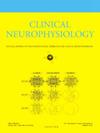Gamma activation spread reflects disease activity in amyotrophic lateral sclerosis
IF 3.6
3区 医学
Q1 CLINICAL NEUROLOGY
引用次数: 0
Abstract
Objective
A non-invasive measure of cerebral motor system dysfunction would be valuable as a biomarker in amyotrophic lateral sclerosis (ALS). Task-based magnetoencephalography (tMEG) measures the magnetic fields generated by cortical neuronal oscillatory activity during task performance. Gamma activations are periods of high-power and high-frequency cortical oscillations integral to motor control.
Methods
tMEG was undertaken during 60 bilateral isometric hand grip exercises in ALS (n = 42) and compared with healthy controls (HC, n = 33). Gamma activation spread (GAS) was estimated by calculating the number of activated regions during each 100 ms time-bin and compared statistically between groups. Gamma activation patterns were visualised by plotting each participant’s brain activity separately as a 2-dimensional video.
Results
There was no difference in grip strength between groups. GAS was greatly increased in the ALS group compared to HC (p < 0.001) and correlated positively with rate of ALSFRS-R progression (t = 1.35, p = 0.023) and a fine motor sub-score (t = -1.18, p = 0.047).
Conclusions
ALS was associated with a marked increase in regional spread of gamma frequency activation, greater in those with higher disease progression rates.
Significance
The regional spread of gamma activity may reflect disease activity in ALS, with potential application as an experimental medicine readout.
肌萎缩性侧索硬化症的γ激活扩散反映疾病活动。
目的:一种无创的脑运动系统功能障碍测量方法有望作为肌萎缩侧索硬化症(ALS)的生物标志物。任务型脑磁图(tMEG)测量任务执行过程中皮层神经元振荡活动产生的磁场。伽马激活是运动控制不可或缺的高功率和高频皮层振荡周期。方法:对60例肌萎缩侧索硬化症患者(n = 42)进行双侧等距握力训练,并与健康对照组(n = 33)进行比较。通过计算每100 ms时间内激活区域的数量来估计伽马激活扩散(GAS),并在组间进行统计比较。伽马激活模式通过将每个参与者的大脑活动单独绘制成二维视频来可视化。结果:两组间握力无明显差异。与HC相比,ALS组的GAS显著增加(p)。结论:ALS与伽马频率激活的区域扩散显著增加相关,在疾病进展率较高的患者中更为明显。意义:γ活性的区域分布可能反映ALS患者的疾病活动性,具有作为实验医学读数的潜在应用价值。
本文章由计算机程序翻译,如有差异,请以英文原文为准。
求助全文
约1分钟内获得全文
求助全文
来源期刊

Clinical Neurophysiology
医学-临床神经学
CiteScore
8.70
自引率
6.40%
发文量
932
审稿时长
59 days
期刊介绍:
As of January 1999, The journal Electroencephalography and Clinical Neurophysiology, and its two sections Electromyography and Motor Control and Evoked Potentials have amalgamated to become this journal - Clinical Neurophysiology.
Clinical Neurophysiology is the official journal of the International Federation of Clinical Neurophysiology, the Brazilian Society of Clinical Neurophysiology, the Czech Society of Clinical Neurophysiology, the Italian Clinical Neurophysiology Society and the International Society of Intraoperative Neurophysiology.The journal is dedicated to fostering research and disseminating information on all aspects of both normal and abnormal functioning of the nervous system. The key aim of the publication is to disseminate scholarly reports on the pathophysiology underlying diseases of the central and peripheral nervous system of human patients. Clinical trials that use neurophysiological measures to document change are encouraged, as are manuscripts reporting data on integrated neuroimaging of central nervous function including, but not limited to, functional MRI, MEG, EEG, PET and other neuroimaging modalities.
 求助内容:
求助内容: 应助结果提醒方式:
应助结果提醒方式:


